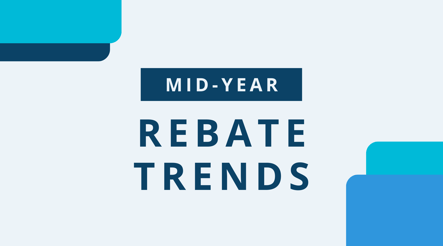
This analysis is based on program changes for both downstream and midstream incentive programs through the first six months of 2021.
Every February, Encentiv Energy hosts a webinar to demonstrate how commercial rebate programs have changed over the previous year. This year, we’ve decided to take a look at where programs stand mid-year to give an earlier look into changes and trends that we are seeing across the country.
A downstream program is when the customer or contractor must submit an application after installing the product, this is what is considered to be the traditional rebate program. Midstream programs started out in the residential sector but have made their way into commercial programs in recent years, these rebates are applied at the point of sale when a customer purchases a product from a qualifying distributor.
Downstream incentives remained fairly consistent across all categories over the six month period, with some variation program to program that resulted in rates remaining flat on average. Midstream incentives, however, showed growth across almost every category tracked in our database.
Downstream Programs
In this section, we’ll focus on programs that made incentive changes across many categories or across their entire program, rather than just increases in a handful of categories.
Overall there was little variation across utilities for downstream incentives. Among the 69 programs nationwide that showed incentive increases or decreases for downstream categories, there was roughly a zero percent change in incentives on average. This indicates that utilities have kept downstream incentives relatively steady over the first six months of 2021.
While downstream as a whole remained largely consistent, there were some standout utilities and categories that experienced increases and decreases.
Programs like PECO and FirstEnergy PA showed increases across the board, with the new program phase starting in Pennsylvania and new funding available. First Energy PA restored its incentive rate to $0.05/kWh saved after reducing it to $0.025/kWh saved in the previous year.
Idaho Power is the first example of a program that showed changes across many categories, administering increases for 50 product categories. The majority of changes ranged from about 10% to 20% increases, but the five tube categories doubled: Four-Foot Linear Replacement Lamps, Two-Foot Linear Replacement Lamps, Three-Foot Linear Replacement Lamps, Eight-Foot Replacement Lamps and U-Bend Replacement Lamps.
Maryland had two utility programs that increased incentives for 45 categories each, Pepco and Delmarva Power. On average, both programs increased category incentives by 75% and more than doubled incentives for 15 categories.
Additionally, Efficiency United - Hillsdale (MI), changed 45 category incentives. The majority of these were increases, with Exit Sign incentives increasing the most by 67%.
A few programs showed decreases across many categories, most notably Ameren Illinois decreased from $0.45 per Watt reduced to $0.20 per Watt reduced, a 56% decrease across 67 downstream categories.
Fixtures like high bays and troffers showed net decreases, while their retrofit kit and replacement lamp counterparts showed increases on the whole. These fixture categories were also some of the most commonly increased in midstream programs, showing a shift for these categories that have traditionally existed solely in downstream programs.
Midstream Programs
In this section we’ll focus on midstream incentive changes across entire programs and a few categories that were more notable based on incentive growth. Unlike downstream, there was a clear trendline for midstream programs, as there was incentive growth across the board.
Midstream incentives across all programs increased by 74% on average. We’ll highlight some of the programs that stood out with significant growth across categories.
PECO, which almost tripled incentive rates across 42 categories, was the largest driver of this overall increase. The majority of their midstream incentives doubled or more than doubled and some even increased fivefold, including single sided Exit Signs going from $3 to $15 and 2x2 troffers going from $4 to $20.
Another couple of drivers of the overall growth were Orange & Rockland (NY) and Efficiency Vermont (VT), both of which changed incentives for 35 and 34 categories (all increases), respectively.
Orange & Rockland increased category incentives by roughly 35% across all categories, whereas Efficiency Vermont had a little more variation in its changes. The program raised category incentives by between 25% and 75% in most cases, but doubled them for six categories including Recessed Downlights, Wall-Wash Luminaires, and Downlight Solid State Retrofit fixtures.
Mass Save (MA) increased incentives across 23 categories, averaging to a 28% increase overall. Notably, it doubled incentives for Downlight Solid State Retrofit kits and U-Bend Replacement Lamps, while Four-Foot Linear Replacement Lamp incentives more than doubled.
There was only one category that showed a net decrease in midstream incentives from our analysis (8 ft tubes), while a handful of categories stood out with more growth than others.
As mentioned above, many fixture rebates have been trending toward midstream programs, with high and low bays seeing some significant increases in midstream. In programs that changed their high and low bay midstream incentives in the past six months, the incentive doubled on average.
All of the utilities mentioned above--PECO, Orange & Rockland, Efficiency Vermont, and Mass Save showed significant improvement in high and low bay midstream rebates.
Conclusion
We concluded our analysis by reviewing product categories that were either removed or added to rebate programs nationwide. Overall, utilities nationwide remained consistent with what incentives were offered for both downstream and midstream programs, with most of the variation coming from increases or decreases in incentive rates rather than adding or removing incentive categories.
Coauthored with Jeremy Struhar, Product Manager, Encentiv Energy
.png?width=500&name=2019%20e%20news%20spotlight%20logo%20(1).png)




